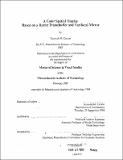| dc.contributor.advisor | Andrew Lippman. | en_US |
| dc.contributor.author | Carson, Kenneth M | en_US |
| dc.contributor.other | Massachusetts Institute of Technology. Dept. of Architecture. | en_US |
| dc.date.accessioned | 2012-08-21T15:40:51Z | |
| dc.date.available | 2012-08-21T15:40:51Z | |
| dc.date.copyright | 1984 | en_US |
| dc.date.issued | 1985 | en_US |
| dc.identifier.uri | http://hdl.handle.net/1721.1/72246 | |
| dc.description | Thesis (M.S.V.S.)--Massachusetts Institute of Technology, Dept. of Architecture, 1985. | en_US |
| dc.description | MICROFICHE COPY AVAILABLE IN ARCHIVES AND ROTCH. | en_US |
| dc.description | Includes bibliographical references (leaves 66-70). | en_US |
| dc.description.abstract | A very simple 30 color display has been constructed. It consists of a 20 display viewed in a rapidly vibrating varifocal mirror. The changing focal length of the mirror is responsible for providing the depth; when the mirror is forward, the image appears closer, and when the mirror is back, the image appears further away. The mirror motion is synchronized with the refresh of the 20 monitor to form stable spatial images. The mirror is simply a bass drum with a commercially available aluminized mylar drum head on one side and a hifi woofer on the other side to provide the driving force. The 20 display is a standard black and white X-Y plotting monitor with a Tektronix liquid crystal color shutter to provide red/green sequential color. The X-Y plotting monitor is driven with signals from a 24-bit raster graphics framebuffer. In total, this is a remarkably inexpensive spatial display, and the first of its kind to incorporate multicolor imagery. This paper surveys much of the work in 30 that has led to the techniques employed in the project The bass drum spatial display is described in detail, including hardware, software, and other practical concerns of its design, plus techniques for realtime interaction. Applications that require a good spatial display are discussed as motivation for this work. | en_US |
| dc.description.statementofresponsibility | by Kenneth M. Carson. | en_US |
| dc.format.extent | 70 leaves | en_US |
| dc.language.iso | eng | en_US |
| dc.publisher | Massachusetts Institute of Technology | en_US |
| dc.rights | M.I.T. theses are protected by
copyright. They may be viewed from this source for any purpose, but
reproduction or distribution in any format is prohibited without written
permission. See provided URL for inquiries about permission. | en_US |
| dc.rights.uri | http://dspace.mit.edu/handle/1721.1/7582 | en_US |
| dc.subject | Architecture. | en_US |
| dc.title | A color spatial display based on a Raster framebuffer and varifocal mirror | en_US |
| dc.title.alternative | Raster framebuffer and varifocal mirror, A color spatial display based on a | en_US |
| dc.type | Thesis | en_US |
| dc.description.degree | M.S.V.S. | en_US |
| dc.contributor.department | Massachusetts Institute of Technology. Department of Architecture | |
| dc.identifier.oclc | 14137265 | en_US |
